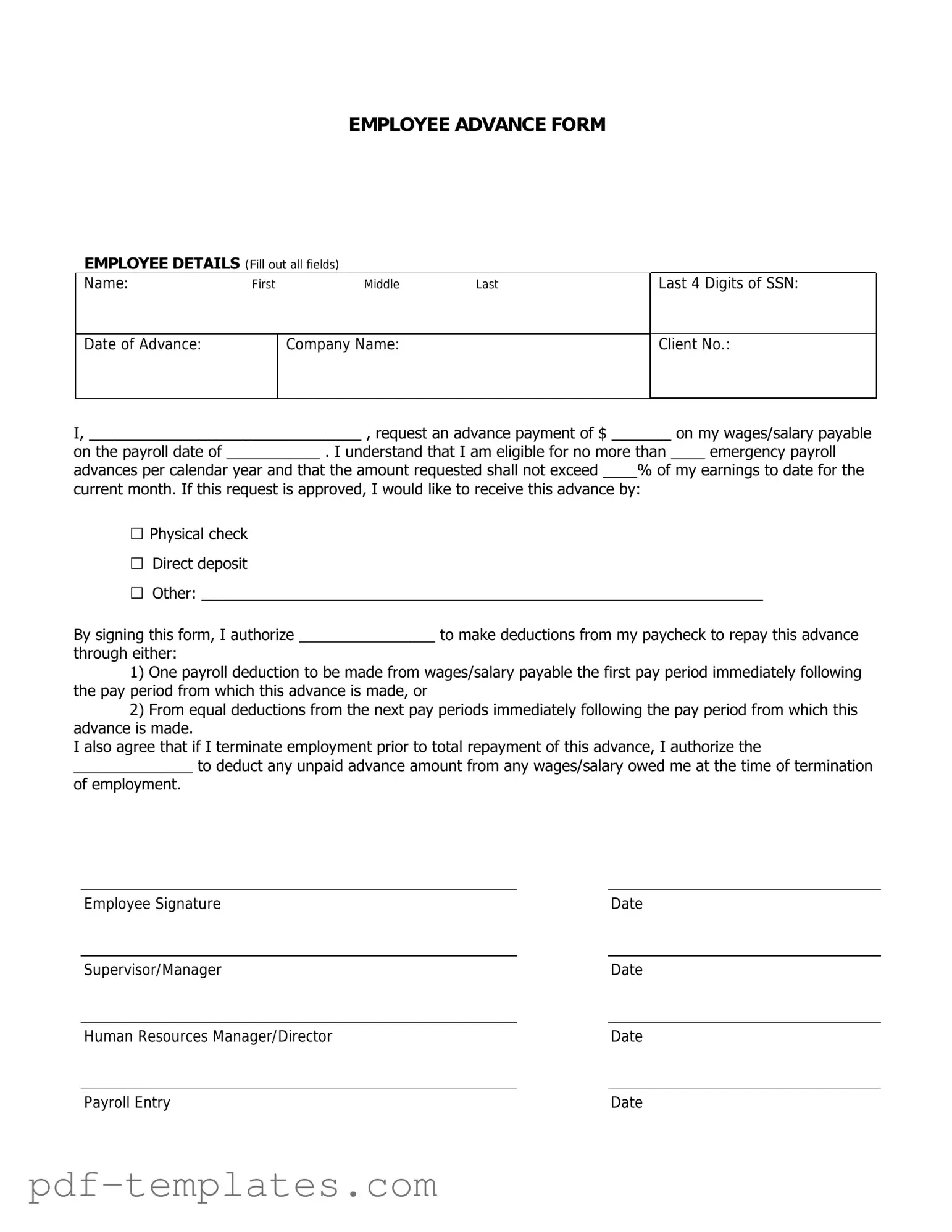The Employee Expense Reimbursement form serves a similar purpose as the Employee Advance form. Both documents are designed to facilitate financial transactions between employees and the organization. The Expense Reimbursement form allows employees to claim back money spent on behalf of the company, ensuring they are compensated for legitimate business expenses. Like the Employee Advance, it requires detailed documentation and justification for the expenses incurred, promoting transparency and accountability in financial dealings.
The Payroll Deduction Authorization form is another document that aligns closely with the Employee Advance form. This document allows employees to authorize deductions from their paychecks for various purposes, such as loan repayments or benefits contributions. Both forms require employee consent and often involve financial transactions that impact the employee's earnings. The Payroll Deduction Authorization ensures that employees are aware of and agree to any deductions, similar to how the Employee Advance form outlines the terms of an advance.
The Travel Authorization form is also comparable to the Employee Advance form. This document is used to obtain approval for business-related travel expenses before they are incurred. Like the Employee Advance, it involves planning for future expenditures and requires managerial approval. Both documents aim to ensure that employees are prepared for expenses while maintaining the organization's budgetary constraints and policies.
The Loan Agreement form shares similarities with the Employee Advance form as well. This document outlines the terms and conditions under which an employee may receive a loan from the employer. Both forms involve financial assistance provided to employees, often requiring a repayment plan. The Loan Agreement typically includes details about interest rates and repayment schedules, while the Employee Advance form focuses on the immediate financial support needed for business-related expenses.
The Purchase Order form is another document that bears resemblance to the Employee Advance form. It is used to request the purchase of goods or services and often requires approval from management. Both forms are integral to managing company finances and ensuring that expenditures align with company policies. The Purchase Order form initiates the procurement process, while the Employee Advance form facilitates immediate cash flow for employees on business-related matters.
The Requisition form is similar to the Employee Advance form in that it initiates a request for goods or services needed by the organization. Employees fill out this form to specify what they need, which then goes through an approval process. Both documents require justification for the request, ensuring that all expenditures are necessary and align with company policies. The Requisition form ultimately helps manage resources effectively, just as the Employee Advance form does for employee expenses.
Understanding the various forms that facilitate financial transactions within a business is essential, as seen with the Employee Advance form, which shares similarities with other documents like the Travel Expense Reimbursement form and the Mileage Reimbursement form. Employees must navigate these forms to ensure they manage funds effectively for operational needs. For further ease in documentation, one can refer to All California Forms to secure comprehensive resources tailored for various financial agreements and requests.
Lastly, the Timesheet form can be viewed as similar to the Employee Advance form. While primarily used to record hours worked, it also plays a crucial role in the financial aspect of employment. Employees must document their hours to ensure they are compensated accurately. Both forms require attention to detail and accurate reporting, as they directly affect an employee's financial relationship with the organization. Proper completion of the Timesheet form ensures that employees receive the correct payment, much like the Employee Advance form ensures they receive the necessary funds for business-related expenses.
